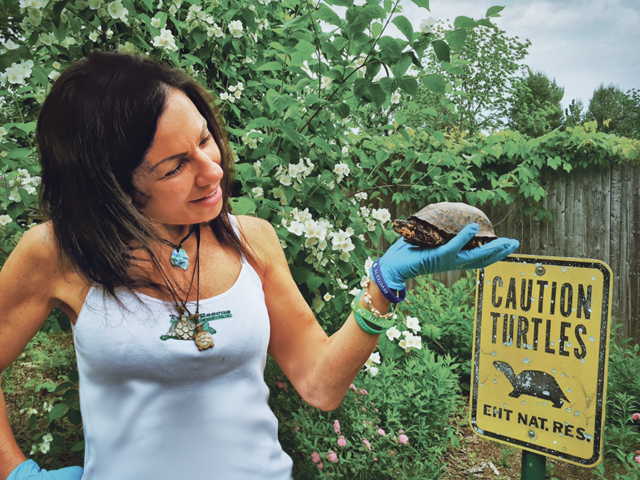Suffolk Closeup: In Jamesport, they’re looking out for turtles


It’s tough being a turtle on Long Island.
“Turtle Rescue,” answered Karen Testa last week on the “emergency line” at the century-old farmhouse at 111 Manor Lane in Jamesport, where she and her staff care for the amphibians.
It was another in a blizzard of daily and nightly calls about a turtle in need.
“I sleep with the phone next to my bed,” she explained. “I’m here 24-7.”
The turtles have come from all over Long Island, Ms. Testa said.
She enumerated the many threats facing turtles here. Cars on all the highways regularly run into and over them. Bulldozers involved in construction are devastating to the creatures. Boat propellers rip into turtles in Long Island waters. Pieces of fishing line ensnare them. Pesticides, weed-killers and other chemicals leave turtles sick. People take hatchling turtles from Long Island shores. Ms. Testa’s list of the perils turtles face goes on and on.
She was 3 years old, Ms. Testa recounted, when she had an experience that sparked her commitment to take care of turtles. She was visiting her grandmother in Worcester, Mass., and they were visiting a park.
“I saw a turtle with three legs,” she recalled. “I felt so sorry for this animal and what it had gone through — a leg ripped from its body.”
This resulted in a “place in my heart” for turtles, Ms. Testa said.
A New York State licensed wildlife rehabilitator with other state certifications to care for turtles, Ms. Testa, who is from the Village of Poquott near Setauket, went to Southampton College, where she majored in marine biology. She volunteered at the Evelyn Alexander Wildlife Rescue Center in Hampton Bays and then “branched off” to establish Turtle Rescue of the Hamptons. (Although it’s on the North Fork, Hamptons has continued to be included in its formal name because of its origin with Ms. Testa’s work at the Wildlife Rescue Center.) Turtles, she explained, “need special care” different from the care provided for “mammals and avians.”
Turtle Rescue is a not-for-profit 501c3 charitable endeavor that is always looking for donations. As its website states, “Our mission is to rescue, rehabilitate and release wild chelonian species native to Long Island, to provide sanctuary with a high quality of life for those who have sustained permanent disability, and to allow injured animals to live out their lives with dignity and respect. We work to promote a safe and healthy natural environment by providing public education services regarding the threats and challenges facing our native population.”
It goes on to note that Turtle Rescue’s “state of the art rehabilitation facility” is called “Turtle Manor.” (Until writing this column, I didn’t know about the word chelonian but, as Google explains, it denotes “a turtle, terrapin, or tortoise.”)
I didn’t know about Turtle Rescue either until my old friend Jennifer Puleston Clement of Brookhaven sent me a message on Facebook relating how she had found a box turtle that “some low-life driver smashed up” and was referred by a local “rehab center” to Ms. Testa’s “full-time turtle-exclusive” facility.
“This woman is sincere in her devotion to the rehabilitation of our dwindling population of turtles,” Ms. Clement said, suggesting a piece be written.
At Turtle Manor “every room has a special purpose,” Ms. Testa said. This includes a room called an ICU and facilities to perform X-rays and provide oxygen to ill turtles. Outside are small ponds.
Ms. Testa, the executive director of Turtle Rescue, is assisted by three licensed veterinarians, two licensed vet technicians and three marine biologists.
“We’ve been super busy from the day we opened,” she said. There are good Samaritans (like Ms. Puleston) bringing turtles to Turtle Rescue and there is the constant stream of phone calls leading to the picking up of turtles in trouble and bringing them back to Turtle Manor for care. The number of the emergency line at Turtle Rescue is 631-779-3737. Its website is turtlerescueofthehamptons.org.
Representative of the plight of turtles on Long Island is the situation involving the Box Turtle, that sweet creature common for so long here. However, noted Ms. Testa last week, the New York State Department of Environmental Conservation recently listed Box Turtles as “a species of special concern.”
“Box Turtles were common on Long Island, but not any longer because of habitat destruction,” she said.
Atop the Turtle Rescue website is this appeal: “Help us save turtles. Please don’t turn your back on an injured turtle! They depend on us to make a difference.”
Photo Caption: Karen Testa, executive director of Turtle Rescue, has dedicated her life to protecting the wild chelonian species native to Long Island. (Credit: Karl Grossman)
 The author is a veteran journalist and professor and a member of the Press Club of Long Island’s Journalism Hall of Fame. His Suffolk Closeup column is syndicated in newspapers across the county.
The author is a veteran journalist and professor and a member of the Press Club of Long Island’s Journalism Hall of Fame. His Suffolk Closeup column is syndicated in newspapers across the county.








